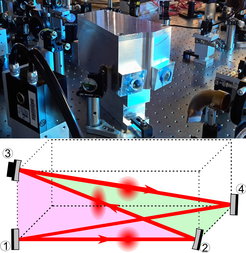New laser technology from Hannover enables more sensitive gravitational-wave detectors
Further strengthening of research at the AEI and the Laser Zentrum Hannover
One year ago, the first direct detection of gravitational waves was announced. Laser experts from the Max Planck Institute for Gravitational Physics (Albert Einstein Institute; AEI), from the Leibniz Universität Hannover, and from the Laser Zentrum Hannover e.V. (LZH) played leading roles in this discovery, because their super-precise laser technology at the heart of the LIGO instruments in the USA enabled the detection of weak gravitational-wave signals. Now, AEI researchers have presented two new technologies capable of further increasing the sensitivity of future gravitational-wave detectors. The Max Planck Society now strengthens the development of laser systems for third-generation gravitational-wave detectors. The AEI, in collaboration with the LZH, receives over the next five years 3.75 million Euro research funding for the development of novel lasers and stabilization methods.
“We have made two important breakthroughs,” says Apl. Prof. Benno Willke, leader of the laser development group at the AEI. “Our work is another step towards using a novel type of laser beam profile in interferometric gravitational-wave detectors. Furthermore, we have shown how to increase the power stability of the high-power lasers used in the detectors. These are important steps towards the future of gravitational-wave astronomy.” The results were published in the renowned science journal Optics Letters and were highlighted by the editors.
More homogeneous laser beams

The beams of all laser systems currently used in gravitational-wave detectors have higher intensity at the centre than at the edges. This leads to an undesirable strong influence of mirror surface fluctuations on the measurement precision of gravitational-wave detectors. This so-called thermal noise can be reduced by a more homogeneous laser intensity distribution.
In 2013 a team with AEI involvement showed how more homogeneous high-power laser beams in the so-called LG33 mode can be created. Now, Andreas Noack has studied in his MSc thesis in Benno Willke‘s team how these laser beams can be fed into future gravitational-wave detectors.
The first step on the way into the detector is a device known as a pre-mode cleaner, which optimizes the beam profile and reduces beam jitter. Willke‘s team showed that the new LG33 beam is incompatible with the pre-mode cleaners currently in use. The researchers also showed how to solve this problem. They developed a new pre-mode cleaner, which is compatible with the LG33 laser beams.
“The design of the next-generation gravitational wave detectors is not set,” says Willke. “Therefore, we are testing different types of lasers to have as many options for new gravitational wave detectors as possible. We now have made a big step ahead with the promising LG33 beams.”
Improving laser power stability for new gravitational-wave detectors
All interferometric gravitational-wave detectors like LIGO, Virgo, and GEO600 rely on laser systems that keep their high output power stable over years and that show very little short timescale power fluctuations. Benno Willke‘s research group plays a world-wide leading role in this research area. They constructed the laser systems for GEO600 and Advanced LIGO, without which the first direct detection of gravitational waves in September 2015 would not have been possible.

Now, Jonas Junker has further refined the existing power stabilization system in his MSc thesis in Willke‘s team. A part of the laser light is picked off and distributed on multiple photodetectors to precisely determine the total laser power. If it varies, the main laser power is corrected accordingly. In their experiment, the scientists extended the current system by adding, among other things, another photodetector to also control and correct the pointing of the laser beam.

The improved power stabilization scheme has been successfully applied to the 35 Watt laser system of the 10 meter prototype interferometer at the AEI. The prototype is used by researchers in Hannover for demonstrations and tests of technologies for the third generation of detectors and for research on quantum mechanical effects in these instruments. The level of power stability reached is five times higher than that in comparable experiments of other groups. This value agrees very well with results from isolated table-top experiments.
“An experiment in the well isolated environment of an optical laboratory is completely different from a complex large-scale experiment like the 10 meter prototype. We have shown for the first time that it is possible to transfer the excellent stability level from a table-top experiment,” says Willke. “We show that these photodiode arrays work as expected, meaning it should also be possible to achieve this high stability with the identical multi-photodetector arrays used in Advanced LIGO.”
Funding for the future of laser development
Researchers in Hannover will continue to play a leading role in the development of super-precise laser systems for gravitational-wave astronomy in the future. The Max Planck Society supports the development of laser systems for the third-generation detectors in a new project. The AEI receives additional funds of 3.75 million Euros over the next five years for this project and the continued collaboration with the LZH.














